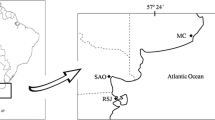Abstract
The ark shell Anadara granosa is a species peculiar to the Ariake Sound. To determine why distribution of A. granosa in Japan is largely confined to this area, we examined feeding and growth of A. granosa as functions of environmental and biological variables. The results were compared with those of another ark shell Scapharca subcrenata, which is ubiquitous in Japan. Feeding experiments indicated that A. granosa is eurythermal and euryhaline, as is S. subcrenata, but is adapted to temperature slightly higher than S. subcrenata. Weight-specific clearance rate (CR) of A. granosa as a function of soft-body dry-weight (w) followed the power function of w (CR=2.7×w −0.37), with coefficient and exponent very close to those for S. subcrenata. Growth rate of A. granosa increased linearly with daily ration, similar to S. subcrenata. Thus, feeding and growth characteristics of A. granosa were comparable to those of S. subcrenata and no ‘peculiarities’ of the former were detected. Therefore, the factors that make A. granosa a species restricted to the sound are probably not directly related to feeding or growth characteristics.
Similar content being viewed by others

References
Ministry of Agriculture, Forestry and Fisheries of Japan. FY2005 Trends in fisheries. [cited May 17, 2007.] Available from URL: http://www.maff.go.jp/ettitle.html
Sato M, Takita T. Biota and environment in Ariake Sea. In: Sato M (ed.) Life in Ariake Sea: Biodiversity in Tidal Flats and Estuaries. Kaiyusha, Tokyo. 2000; 10–36 (in Japanese).
Bernard FR, Cai YY, Morton B. Catalogue of the Living Marine Bivalve Molluscs in China. Hong Kong University Press, Hong Kong. 1993.
Sato S. Bivalves in the Ariake Sea with special referenceto Isahaya Bay. In: Sato M (ed.). Life in Ariake Sea: Biodiversity in Tidal Flats and Estuaries. Kaiyusha, Tokyo, 2000; 150–183 (in Japanese).
Kawahara I, Yamaguchi T, Ohkuma H, Ito S. Studies on seed production of Scapharca globosa ursus, in the innermost area of Ariake Sound I. Collecting eggs and development. Bull. Saga Pref. Ariake Fish. Res. Dev. Center 2003; 21: 23–28.
Ito S, Eguchi T, Yoshimoto M Maturation and spawning of the ursine ark shell, Scapharca globosa ursus, in the innermost are a of Ariake Sound. Bull. Saga Pref. Ariake Fish. Res. Dev. Center 1999; 19: 17–24.
Broom MJ. Analysis of the growth of Anadara granosa (Bivalvia: Arcidae) in natural, artificially seeded and experimental populations. Mar. Ecol. Prog. Ser. 1982; 9: 69–79.
Broom MJ. Gonad development and spawning in Anadara granosa (L.) (Bivalvia: Arcidae). Aquaculture 1983; 30: 211–219.
Davenport J, Wong TM. Responses of the blood cockle Anadara granosa (L.) (Bivalvia: Arcidae) to salinity, hypoxia and aerial exposure. Aquaculture 1986; 56: 151–162.
Nakamura Y. Suspension feeding of the ark shell Scapharca subcrenata as a function of environmental and biological variables. Fish. Sci. 2005; 71: 875–883.
Nakamura Y. Suspension feeding and growth of juvenile Manila clam Ruditapes philippinarum reared in the laboratory. Fish. Sci. 2004; 70: 215–222.
Bayne BL, Newell RC. Physiological energetics of marine molluscs. In: Wilbur KM, Saleuddin ASM (eds) The Mollusca, Vol. 4. Physiology, Part 1. Academic Press, New York, NY. 1983; 407–515.
Yukihira H, Klumpp DW, Lucas JS. Effects of body size on suspension feeding and energy budgets of the pearl oysters Pinctada margaritifera and P. maxima. Mar. Ecol. Prog. Ser. 1998; 170: 119–130.
Nakamura Y, Hashizume K, Koyama K, Tamaki A. Effects of salinity on sand burrowing activity, feeding and growth of the clams Mactra veneriformis, Ruditapes philippinarum and Meretrix lusoria. J. Shellfish Res. 2005; 24: 1053–1059.
Yamamoto M, Hagino S, Ishida K. Study on physical factors to design of aquaculture grounds for short-necked clams. Bull. Natl Res. Inst. Fish. Eng. 1995; 16: 1–28.
Petit JR, Raynaud D, Barkov NI, Barnola J-M, Basile I, Bender M, Chappellaz J, Davis M, Delaygue G, Delmotte M, Kotlyakov VM, Legrand M, Lipenkov VY, Lorius C, Pepin L, Ritz C, Saltzman E, Stievenard M. Climate and atmospheric history of the past 420 000 years from the Vostok ice core, Antarctica. Nature 1999; 399: 429–436.
Matsushima Y. Shallow marine molluscan assemblages of Postglacial period in the Japanese Islands — its historical and geographical changes induced by the environmental changes. Bull. Kanagawa Pref. Mus. (Nat. Sci.) 1984; 15: 37–109.
Banse K. Determining the carbon to chlorophyll ratio of natural phytoplankton. Mar. Biol. 1977; 41: 199–212.
Author information
Authors and Affiliations
Corresponding author
Rights and permissions
About this article
Cite this article
Nakamura, Y., Shinotsuka, Y. Suspension feeding and growth of ark shell Anadara granosa: comparison with ubiquitous species Scapharca subcrenata . Fish Sci 73, 889–896 (2007). https://doi.org/10.1111/j.1444-2906.2007.01410.x
Received:
Accepted:
Issue Date:
DOI: https://doi.org/10.1111/j.1444-2906.2007.01410.x



